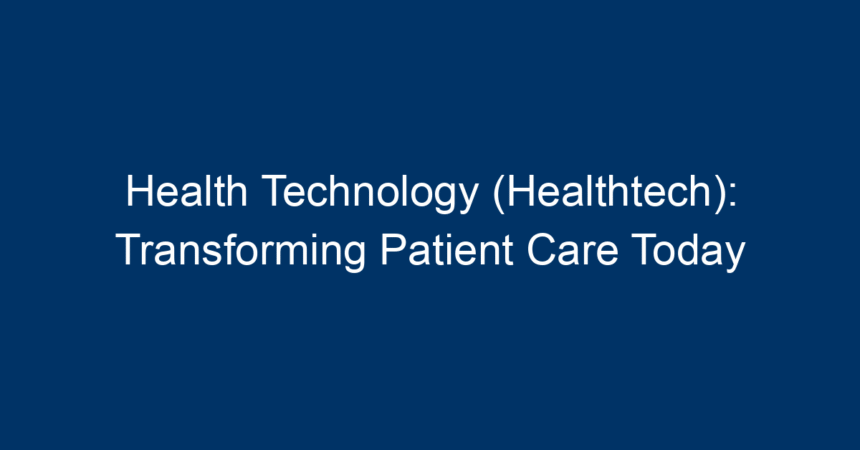In recent years, health technology (healthtech) has emerged as a powerful catalyst for change in the healthcare landscape. From telehealth services to artificial intelligence (AI) diagnostics, healthtech innovations are reshaping how healthcare providers deliver patient care. This article explores the profound impact of health technology on patient care, delving into its benefits, challenges, and the future of healthcare.
What is Health Technology (Healthtech)?
Health technology, often referred to as healthtech, encompasses a wide range of tools and services designed to optimize medical care, enhance patient outcomes, and streamline healthcare processes. This includes everything from wearable devices that monitor health metrics to sophisticated software applications that assist clinicians in making informed decisions.
The Evolution of Health Technology
The evolution of health technology is deeply rooted in the advancements of digital and medical technologies. Over the past few decades, we’ve witnessed remarkable shifts—from the introduction of electronic health records (EHRs) to the rise of mobile health applications, all aimed at improving patient engagement and care quality.
How Healthtech is Transforming Patient Care
1. Telehealth: Access to Care Anywhere
One of the most notable developments in health technology is telehealth. This service leverages video conferencing, mobile apps, and other digital platforms to deliver healthcare at a distance.
Benefits of Telehealth
- Increased Accessibility: Patients in rural areas can now consult specialists without traveling long distances, breaking down geographic barriers.
- Convenience: Patients can receive care from the comfort of their homes, reducing their need to take time off work or arrange transportation.
Real-World Impact
During the COVID-19 pandemic, telehealth usage skyrocketed, with many providers adapting quickly to offer virtual consultations. This increased access has proven essential for ongoing care management and even mental health services.
2. Wearable Health Tech: Monitoring Your Health
Wearable devices, such as fitness trackers and smartwatches, have gained traction in the realm of health technology. These devices continuously monitor various health metrics, including heart rate, sleep patterns, and physical activity levels.
Benefits of Wearable Devices
- Real-Time Data: Users and healthcare providers can track changes in health metrics, enabling early detection of potential health issues.
- Empowerment: By actively monitoring their health, patients are more motivated to maintain healthy habits and adhere to treatment plans.
3. Artificial Intelligence: Enhancing Diagnostics
Artificial intelligence is another critical component of health technology transforming patient care. AI algorithms can analyze large datasets much faster than human clinicians, providing insights that can lead to improved diagnoses.
AI in Diagnostics
- Accuracy: AI systems, such as those used in radiology, can identify abnormalities in imaging studies, sometimes outperforming human radiologists.
- Predictive Analytics: AI can analyze trends in patient data to predict health risks, allowing for proactive interventions.
4. Health Information Exchange (HIE)
Health information exchange focuses on the electronic sharing of health information across different healthcare organizations. This ensures that vital patient data is available at all points of care.
Benefits of HIE
- Coordinated Care: Providers can access a patient’s comprehensive medical history, reducing duplicate tests and ensuring a more efficient care process.
- Improved Patient Safety: By having access to complete medical records, healthcare workers can avoid medication errors and provide safer treatment.
Challenges in Health Technology
While health technology holds immense potential for transforming patient care, it also faces significant challenges.
Privacy and Security Concerns
The digitalization of health information raises concerns about patient privacy and data security. Breaches can lead to unauthorized access to sensitive medical information, necessitating robust cybersecurity measures.
Integration with Existing Systems
Many healthcare organizations struggle to integrate new healthtech solutions with existing systems. Achieving interoperability is crucial for ensuring seamless data exchange and continuity of care.
Resistance to Change
Change can be met with skepticism, particularly among healthcare professionals who have relied on traditional methods. Education and training are essential to help clinicians embrace new technologies confidently.
The Future of Health Technology (Healthtech)
As we look to the future, health technology promises to evolve further, integrating seamlessly with everyday patient experiences.
Personalized Healthcare
With advances in genomics and data analytics, health technology will enable personalized treatment plans that cater to the unique needs of individuals, optimizing healthcare for effectiveness and efficiency.
Virtual Reality and Augmented Reality
Virtual and augmented reality applications in healthtech can revolutionize medical training and patient treatment. These technologies can simulate real-life scenarios for training purposes and provide immersive experiences for pain management therapies.
Blockchain for Health Data Security
Blockchain technology offers a promising solution for enhancing the security of health data exchanges. By providing a decentralized ledger, it could ensure the integrity and confidentiality of patient records.
Actionable Insights for Patients and Healthcare Providers
For Patients:
- Stay Updated: Educate yourself on the latest health technologies that can benefit your health and wellness.
- Embrace Telehealth: Don’t hesitate to use telehealth services for consultations, follow-ups, or mental health support.
- Utilize Wearables: Consider investing in wearable technology to track your health metrics actively.
For Healthcare Providers:
- Invest in Training: Ensure that staff are trained in healthtech solutions to maximize their effectiveness and adoption.
- Prioritize Security: Implement stringent cybersecurity measures to protect patient data and instill trust.
- Evaluate New Technologies: Regularly assess and adopt emerging health technologies that could enhance patient care and operational efficiency.
Conclusion
Health technology (healthtech) represents a transformative force in patient care today, enabling greater accessibility, accuracy, and efficiency. As innovations continue to unfold, both patients and healthcare providers must adapt to harness the full potential of these advancements. By embracing health technology, we can look forward to a future of improved health outcomes and more patient-centered care. With informed decisions and proactive strategies, the healthcare system stands to benefit immensely from the ongoing evolution of healthtech.




